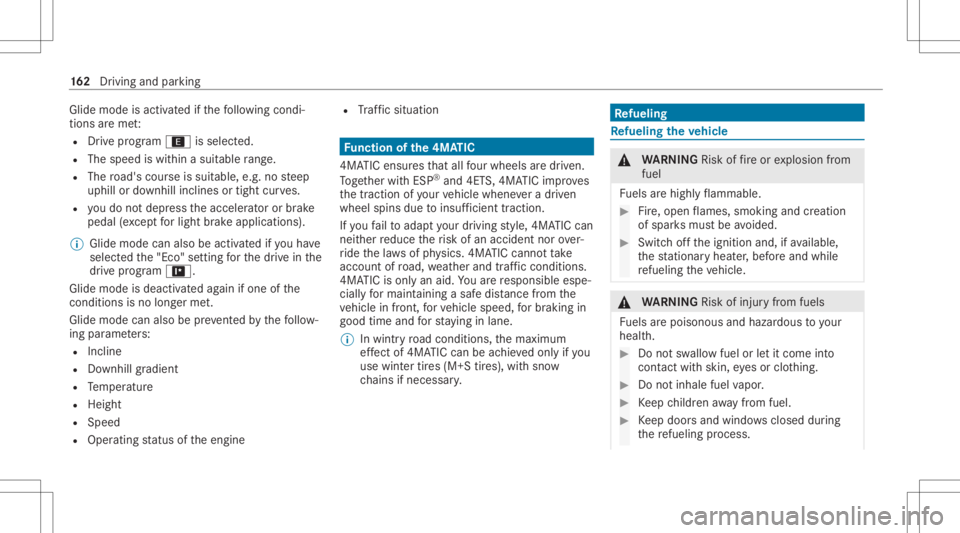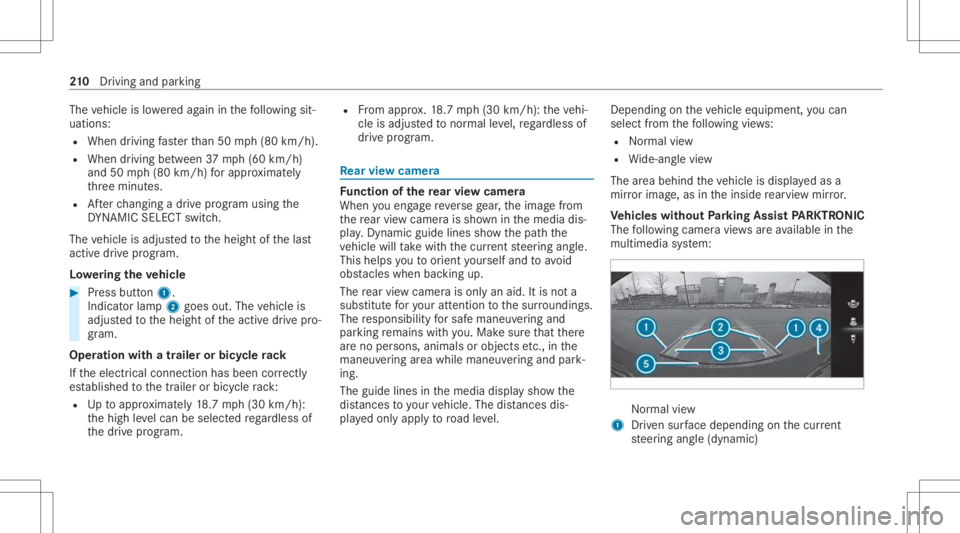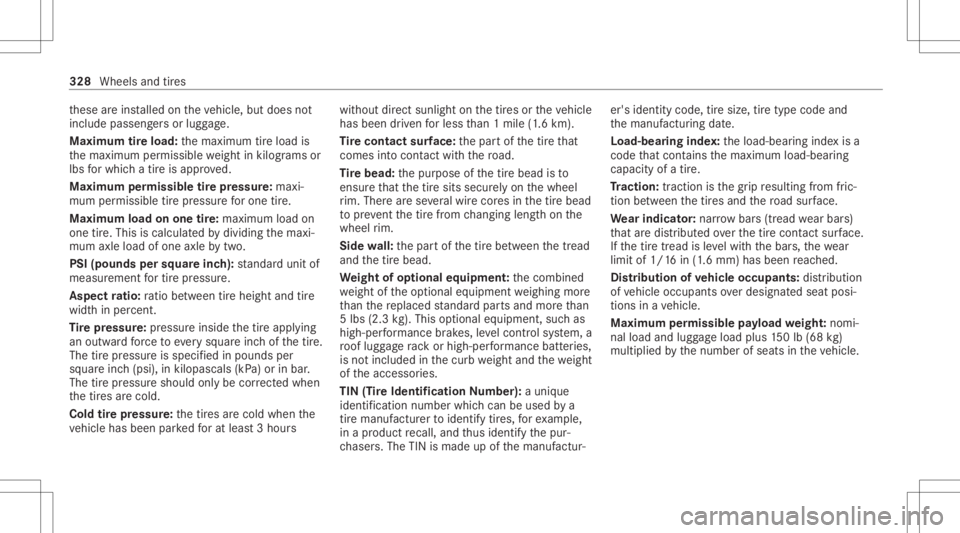2021 MERCEDES-BENZ E CLASS height
[x] Cancel search: heightPage 98 of 450

&
WARNIN GRisk ofinju rydue tohead
re stra int sno tbeing installed orbeing
adjus tedincor rectl y
If hea dre stra int sha ve notbe en installed or
ha ve notbe en adjus tedcor rectly ,th er eis an
incr eased risk ofinjur yin thehead andneck
ar ea, e.g. intheev ent ofan acciden tor when
br aking. #
Alw aysdr ive wit hth ehead restra int s
ins talled. #
Beforedr ivin gof f,mak esur efo rev ery
ve hicle occupant that thecent erofthe
head restra int suppor tsthebac kof the
head atabout eyeleve l. Do
notint erch ang eth ehead restra int sof the
fr ont and rear seat s.Ot her wise, youwill notbe
able toadjus tth eheight andangleof thehead
re stra int scor rectl y.
Ad jus tth ehead restra int fore -and -aftpos ition so
th at itis as clo seasposs ibletothebac kof your
head. #
Toraise: pullthehead restra int up. #
Tolowe r:press release knob 1 inthedir ec‐
tion ofthear row and push thehead restra int
do wn. #
Tomo veforw ards: pullth ehead restra int
fo rw ards. #
Tomo vebac kwards: press release knob 2
and push thehead restra int bac kwards. Ad
jus tingthe fron tse at lux uryhe ad
re stra ints mechanica lly #
Toadjus tth eside bolsters of thehead
re stra int :pull orpush right orleft-han dside
bols ter2. #
Tomo veforw ards: pullth ehead restra int
fo rw ards. 96
Seatsand stow ing
Page 104 of 450

#
Neverlea vechildr enunat tende din the
ve hicle. #
When leaving theve hicle, alwaysta ke
th eSmar tKey wit hyo uand lockth e
ve hicle. #
Tounlo ck:pu sh release leve r1 down as
fa ras itwil lgo. #
Adjus the ight 2 and dist anc e3 tothe
st eer ing wheel. #
Toloc k:push release leve r1 upasfaras it
wil lgo. #
Chec kand makesur eth at thesteer ing col‐
umn isloc kedby mo ving thesteer ing wheel. Ad
jus tingthe steer ing wheel electrically The
steer ing wheel canbeadjus tedwhen the
po we rsupp lyis disco nnect ed. 1
Toadjus tth edis tance tothesteer ing wheel
2 Toadjus tth eheight #
Save these ttings withth ememor yfunc tion
(/ page10 5). 10
2
Sea tsand stow ing
Page 114 of 450

At
tac hin gth epa rcel ne t &
WARNIN GRisk ofinju rydue toobject s
being stowe dincor rectl y
If obje ctsintheve hicle interior arestowe d
inc orrectly ,th ey can slide orbe throw n
ar oun dand hitvehicle occupants. Inaddi‐
tion, cupholder s,open stor ag espaces and
mobile phonebrac kets cann otalw aysre tain
all obje ctsth ey cont ain.
The reisarisk ofinjur y,par ticular lyin the
ev ent ofsudden braking orasudden chang e
in dir ect ion. #
Alw aysst ow object sin suc hawa yth at
th ey canno tbe thro wn around insuc h
sit uation s. #
Alw aysmak esur eth at obj ect sdo not
pr otru de from stor ag espaces, parcel
ne ts or stor ag ene ts. #
Close theloc kable stor ag espaces
bef orest ar tin gajo ur ne y. #
Alw aysst ow and securehea vy,har d,
poin ted, shar p-edg ed,fragile orbulky
objec tsinthetrunk . Obser
vetheno teson loadi ngtheve hicle.
The parcel netis available forall vehicles except
hy brid vehicles. #
Vehicles withth ro ugh- loadin gfe atur ein the
re ar ben chseat :fo ld up thetie-do wneyes. #
Hook parcel net1 intoth efront and rear
tie -do wn eyes. #
Vehicles without ath ro ugh- loadin gfe atur ein
th ere ar ben chseat :hook therings intoth e
par cel nethook s1. #
Place therings intoth ehook son thetrunk
fl oor . EAS
Y-PA CK trunk box Ad
jus tingthe height ofthe EASY-PAC Ktrunk
bo xto anyposi tion &
WARNIN GRisk ofbeco ming trap ped
and injuredwhen raising thefloor
Yo ur han dsma ybec ome trapped onthe
fr ame oftheEA SY-PAC Ktrunk boxand
objects maybe throw nup wa rds. #
Ensur eth at your han dsareno tin the
ra ng eof mo vement ofthefloor . #
Ifsomeone becomestrapped, carefully
push thecent erofthefloor down ward. #
Remo veall obj ect sfrom thefloor
bef orera ising it. 11
2
Sea tsand stow ing
Page 164 of 450

Glide
mode isact ivat ed ifth efo llo wing condi‐
tion sar eme t:
R Drive pr ogr am ; isselec ted.
R The speed iswit hin asuit able rang e.
R The road's courseissuit able, e.g.no steep
uphill ordownhill inclinesortight curves.
R youdo notdepr esstheaccelera toror brak e
peda l(e xc ep tfo rlig ht brak eapp lications).
% Glide mode canalsobe activ ated ifyo uha ve
select edthe"Eco" setting forth edr ive in the
dr ive pr og ram =.
Gli de mode isdea ctivated again ifone ofthe
condi tions isno long erme t.
Gl ide mod ecan also be preve nted bythefo llo w‐
ing parame ters:
R Incline
R Downhill gradi ent
R Temp eratur e
R Height
R Speed
R Oper ating status oftheengine R
Traf fic situ ation Fu
nction ofthe4MA TIC
4MA TICensures that all four wheel sar edr iven .
To ge ther wit hES P®
and 4ETS,4MA TICimprove s
th etra ction ofyour vehicle whene vera dr iven
whee lspins duetoinsuf ficie nttracti on.
If yo ufa ilto adap tyo ur drivin gst yle, 4MA TICcan
neit her reduce therisk ofan accident norover‐
ri de thelaws ofphysics. 4MA TICcannotta ke
acc oun tof road, weather and traf fic condi tions.
4MA TICisonly anaid. Youar ere sponsible espe‐
cially formaint ainingasaf edis tance from the
ve hicle infront, forve hicle speed, forbr aking in
good timeandforst ay ing inlane.
% Inwint ryroad con dition s,themaximum
ef fect of 4MA TICcan beachie vedonl yif yo u
use wint ertires (M+ Stir es), withsn ow
ch ains ifnec essar y. Re
fueli ng Re
fueli ngtheve hicl e &
WARNIN GRisk offire or explosion from
fuel
Fu els arehighly flammab le. #
Fire,open flames ,smo kingand creat ion
of spar ksmus tbe avo ided. #
Swit choffth eignition and,ifav ailable,
th est atio naryheat er,bef oreand while
re fuel ingtheve hicle. &
WARNIN GRisk ofinju ryfrom fuels
Fu els arepoisonous andhazar dous toyour
healt h. #
Donotsw allo wfuel orletit co me into
co ntact withsk in, eyes orclo thing. #
Donotinhale fuelvapor . #
Keep childr enaway from fuel. #
Keep door sand windo wsclos edduring
th ere fuel ingprocess. 16
2
Driving and parking
Page 212 of 450

The
vehicle islowe redag ain inthefo llo wing sit‐
uation s:
R When drivin gfa ster than 50 mph(80 km/h).
R When driving between 37mph(60 km/h)
and 50mph(80 km/h) forapp roxima tely
th re eminut es.
R Afterch ang ingadr ive pr ogram usingth e
DY NA MIC SELE CTswitc h.
The vehicle isadjus tedto theheight ofthelas t
activ edr ive pr ogr am.
Lo we ring theve hicl e #
Press butt on1.
Indicat orlam p2 goes out.Thevehicle is
adjus tedto theheight oftheactiv edr ive pr o‐
gr am.
Oper ation withatrailer orbicy clerack
If th eelectr icalconnect ionhas been correctly
es tablished tothetra iler orbicy clerack :
R Uptoappr oximat ely18 .7 mp h(3 0km/h):
th ehigh leve lcan beselec tedre ga rdless of
th edr ive pr og ram. R
From appr ox.18 .7 mp h(3 0km/h) :th eve hi‐
cle isadjus tedto nor malle ve l,re ga rdless of
dr ive pr ogr am. Re
ar vie wcamer a Fu
nction ofthere ar vie wcamer a
When youen gage reve rsege ar,th eimag efrom
th ere ar vie wcam erais sho wninthemedia dis‐
pla y.Dyna micguide lines showthepat hth e
ve hicle willtake wit hth ecur rent steer ing ang le.
This helps youto orient yourself and toavoid
obs tacle swhe nba cking up.
The rear vie wcam erais on lyan aid. Itis no ta
subs titutefo ryo ur att entio nto thesur round ings.
The responsibili tyforsaf emaneu vering and
pa rking remains withyo u. Mak esur eth at ther e
ar eno per sons, animals orobjec tsetc., inthe
maneu vering area while ma neu vering and park‐
ing.
The guide linesinthemedia displaysho wthe
dis tances toyour vehicle. Thedistances dis‐
pl ay ed onlyapply toroad leve l. Depe
ndingon theve hicle equipment, youcan
sele ctfrom thefo llo wing views:
R Normalvie w
R Wide-ang levie w
The area behind theve hicle isdispla yedas a
mir rorimag e,as intheinside rear vie wmir ror.
Ve hicl eswithout Parking Assis tPA RK TRONI C
The follo wing camer avie ws areav ailable inthe
multime diasystem: Nor
mal view
1 Driven sur face dep endi ngon thecur rent
st eer ing ang le(dynamic) 21
0
Driving and parking
Page 327 of 450

Fi
rs tle tter( s)1 1:
R Without :passeng ervehicle tires accor dingto
Eur opeanma nuf actu ring standar ds.
R "P": passe nger vehicle tires accor dingtoUS
manuf acturingstandar ds.
R "LT": light truc ktir es acc ordin gto US manu‐
fa ctur ingstandar ds.
R "T": com pact emer gency sparewheels with
high tirepr essur eth at areon lydesigned for
te mp orar yuse inan emer gency .
As pec tra tio 3 3:
Ra tio betwee ntir ehe ight and tirewidthin pe r‐
cent (tire height divided bytirewi dth).
Tir eco de 4 4
(tire type ):
R "R"ra dial tire
R "D": bias plytire
R "B": bias beltedtires
R "ZR": radial tirewit hamaximum speedabove
14 9mp h(2 40 km/h) (optional) Rim
diame ter5 5:
The diam eter ofthebead seat(notth ediame ter
of therim flang e).The rim dia me teris specif ied
in inc hes (in).
Load-be aring inde x6 6:
Numer icalcode that spec ifies themaximum
load-bear ingcapacity ofatir e(e.g. "91" cor re‐
sponds to1356 lbs (615 kg)).
The load-bear ingcapacity ofthetir emus tbe at
leas thalf thegr oss axle weight rating ofyour
ve hicle. Donotove rload thetir es by exc eeding
th especif iedload limit.
See also:
R Maximum permissible loadontheTire and
Loadi ngInfo rm atio nplacar d(/ page31 7)
R Maximu mtireload (/ page 323)
R Load index
Spee dra tin g7 7:
Spe cifiesth eappr oved maximum speedofthe
tir e. %
Anelectr onicsp ee dlimi terpr eve nts your
ve hicle from exceeding aspeed of130mp h
(2 10 km/h) .
Ma kesur eth at your tires have there qu ired
speed rating .Yo ucan obtain informat iononthe
re qu ired speed rating from anauthor ized
Mer cedes-B enzCent er.
Summ ertires Inde
xS peedra tin g
Qu pto 100mp h(1 60 km/h)
Ru pto 106mp h(170 km/h)
Su pto 112mp h(1 80 km/h)
Tu pto 118mp h(1 90 km/h)
Hu pto 130mp h(210 km/h)
Vu pto 149mp h(2 40 km/h)
Wu pto 168mp h(2 70 km/h)
Yu pto 186mp h(3 00 km/h) Whee
lsand tires 325
Page 330 of 450

th
ese areins talled ontheve hicle, butdoes not
include passeng ersor lugg age.
Maximum tireload: themaximum tireload is
th emaximum permissible weight inkilog rams or
lbs forwhi chatir eis appr oved.
Maxim umpermissible tirepr essur e:maxi‐
mum permissible tirepr essur efo rone tire.
Maximum loadonone tire: maximu mloa don
one tire. This iscalcu lated bydividing themaxi‐
mum axleload ofone axle bytwo.
PSI (pounds persquar ein ch ):standar dunit of
meas uremen tfo rtir epr essu re.
Aspe ctratio :ra tio betwee ntire height and tire
wi dthin pe rcent .
Ti re pres sur e:press ureinsi dethetir eappl ying
an outw ardfo rc eto eve rysquar einc hof thetir e.
The tirepr essur eis specif iedinpounds per
sq uar einc h(psi), inkilopascals (kPa)or inbar .
The tirepr essur eshould onlybe cor rected whe n
th etir es arecold.
Cold tirepr essur e:thetir es arecold when the
ve hicle hasbeen parkedfo rat lea st3hou rs wit
hout direct sunli ghtonthetir es ortheve hicle
has been driven forless than 1mile (1.6 km ).
Ti re contact surface: thepar tof thetir eth at
com esintocon tact with thero ad.
Ti re bead: thepur pose ofthetir ebead isto
ensur eth at thetir esits secur elyon thewheel
ri m. Ther ear ese veralwir ecor esinthetir ebead
to preve ntthetir efrom chang inglengthon the
wheel rim.
Side wall:thepar tof thetir ebe tween thetread
and thetir ebead.
We ight ofoptiona leq uipm ent:th ecombin ed
we ight oftheop tion aleq uipment weighin gmor e
th an there placed standar dpar tsand moreth an
5 lbs (2.3kg ).This optional equipment, suchas
high-per form anc ebr ak es, leve lcon trol system, a
ro of lugg agera ck orhigh-per form anc ebat teries,
is no tincluded inthecurb weight andthewe ight
of theaccessor ies.
TIN (Tire Identif ication Numbe r):auni que
ident ificat ion numb erwhic hcan beused bya
tir ema nuf actu rerto ident ifytires, forex am ple,
in apr oduc tre cal l,and thus iden tifyth epur‐
ch aser s.The TINismade upofthemanuf actur‐ er's
identit ycode, tiresize, tiretype code and
th emanuf acturingdate.
Load-bear inginde x:theload-bear inginde xis a
code that con tains themaximum load-bearing
capacity ofatir e.
Tr actio n:traction isthegr ip resulting from fric‐
tion between thetir es and thero ad sur face.
We arindi cator:nar row bars(tr ead wearbar s)
th at aredis tribut edove rth etir econ tact surface.
If th etir etread isleve lwit hth ebar s,thewe ar
limit of1/ 16 in(1.6 mm) hasbeen reac hed.
Dis tribut ionofvehicl eoc cupants: distribu tion
of vehicle occupants over designat edseat posi‐
tion sin ave hicle.
Maximum permissible payload weight :nom i‐
nal load andluggageload plus150lb (68 kg)
multip liedby thenumber ofseats intheve hicle. 328
Wheels andtires
Page 352 of 450

er
ant com pressor oil(PAG oil) islocat edon the
inside ofthehood. Inf
ormation label(exa mp le–US A/China)
1 Hazardand service warning symbols
2 Refrig er ant filling capac ity
3 Applic ablestandar ds
4 PAGoil par tnum ber
5 GWP(global warming potentia l)of there frig‐
er ant used
6 Refrig er ant type Inf
ormation label(exa mp le–Canada)
1 Hazardand service warning symbols
2 Refrig er ant filling capac ity
3 Applic ablestandar ds
4 PAGoil par tnum ber
5 GWP(global warming potentia l)of there frig‐
er ant used
6 Refrig er ant type
Symbo ls1 indica tethefo llo wing:
R Possible dangers
R The need tohave ser vice workcar ried out at
a qu alif ied spec ialistwo rkshop only Fi
lling capacityforre frig er ant and PAGoil
Missi ngvalues werenotav ailable attim eof
goin gto print . Model
Refrig er ant
All model s2 4.0±0.4 oz
(6 70 ±10 g) Model
PAGoil
All model s2 .8±0.4 oz
(80 ±10 g) Ve
hicl edata Ve
hicl edimens ions The
heightsspeci fied mayva ry as are sult ofthe
fo llo wing fact or s:
R Tire s
R Load
R Conditio nof thesuspension
R Option aleq uipment 350
Tech nica lda ta